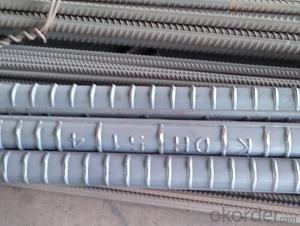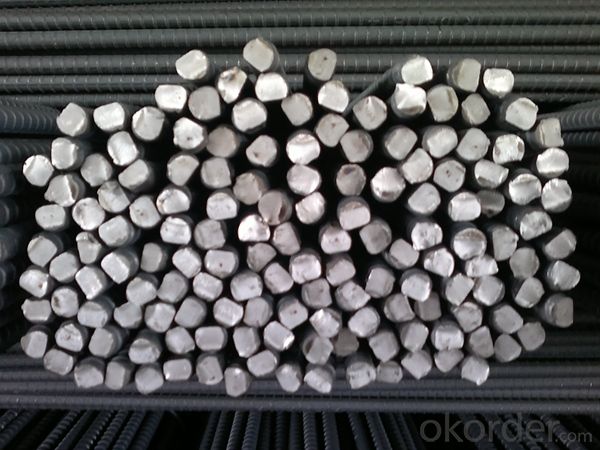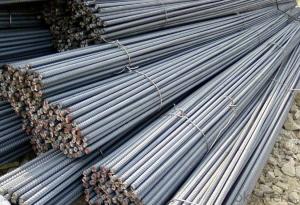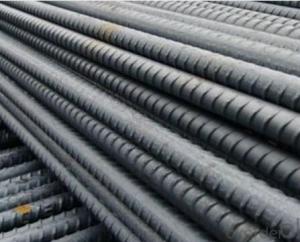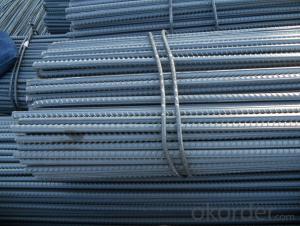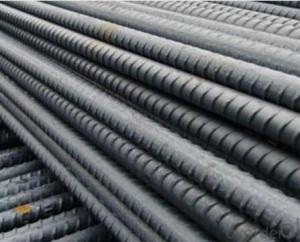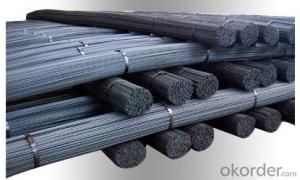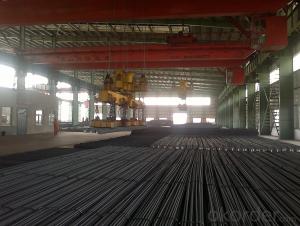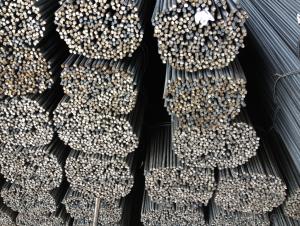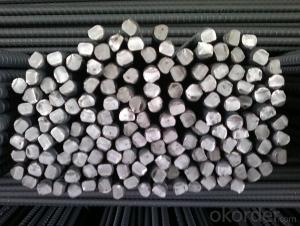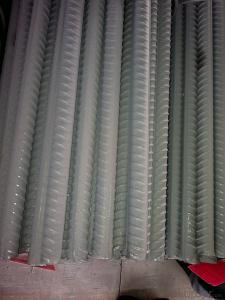Hot Rolled Deformed Steel Rebars for Construction ASTM GR40, 60
- Loading Port:
- Tianjin
- Payment Terms:
- TT or LC
- Min Order Qty:
- 25 m.t.
- Supply Capability:
- 200000 m.t./month
OKorder Service Pledge
OKorder Financial Service
You Might Also Like
Product Description:
OKorder is offering Hot Rolled Deformed Steel Rebars for Construction ASTM GR40, 60 at great prices with worldwide shipping. Our supplier is a world-class manufacturer of steel, with our products utilized the world over. OKorder annually supplies products to European, North American and Asian markets. We provide quotations within 24 hours of receiving an inquiry and guarantee competitive prices.
Product Applications:
Deformed bar is widely used in buildings, bridges, roads and other engineering construction. Big to highways, railways, bridges, culverts, tunnels, public facilities such as flood control, dam, small to housing construction, beam, column, wall and the foundation of the plate, deformed bar is an integral structure material. With the development of world economy and the vigorous development of infrastructure construction, real estate, the demand for deformed bar will be larger and larger.
Product Advantages:
OKorder's Hot Rolled Deformed Steel Rebars for Construction ASTM GR40, 60 are durable, strong, and resist corrosion.
Main Product Features:
· Premium quality
· Prompt delivery & seaworthy packing (30 days after receiving deposit)
· Corrosion resistance
· Can be recycled and reused
· Mill test certification
· Professional Service
· Competitive pricing
Specifications of Hot Rolled Deformed Steel Rebars for Hot Rolled Deformed Steel Rebars for Construction ASTM GR40, 60
Standard | GB UK USA | HRB335 HRB400 HRB500 G460B, B500A, B500B,B500C GR40, GR60 | |
Diameter | 6mm,8mm,10mm,12mm,14mm,16mm,18mm,20mm, 22mm,25mm,28mm,32mm,36mm,40mm,50mm | ||
Length | 6M, 9M,12M or as required | ||
Payment term | TT or L/C | ||
Trade terms | FOB, CFR, CIF | ||
Application | Building, construction | ||
Each bundle weight | 2-3MT, or as required | ||
Type | Hot rolled steel rebar | ||
Brand name | OKORDER | ||
Theoretical weight and section area of each diameter as below for your information:
Diameter(mm) | Section area (mm²) | Mass(kg/m) | Weight of 12m (kg) | Pcs/ton |
6 | 28.27 | 0.222 | 2.664 | 375.38 |
8 | 50.27 | 0.395 | 4.74 | 210.97 |
10 | 78.54 | 0.617 | 7.404 | 135.06 |
12 | 113.1 | 0.888 | 10.656 | 93.84 |
14 | 153.9 | 1.21 | 14.52 | 68.87 |
16 | 201.1 | 1.58 | 18.96 | 52.74 |
18 | 254.5 | 2.00 | 24 | 41.67 |
20 | 314.2 | 2.47 | 29.64 | 33.74 |
22 | 380.1 | 2.98 | 35.76 | 27.96 |
25 | 490.9 | 3.85 | 46.2 | 21.65 |
28 | 615.8 | 4.83 | 57.96 | 17.25 |
32 | 804.2 | 6.31 | 75.72 | 13.21 |
36 | 1018 | 7.99 | 98.88 | 10.43 |
40 | 1257 | 9.87 | 118.44 | 8.44 |
50 | 1964 | 15.42 | 185.04 | 5.40 |
Deformed Steel Rebar in warehouse
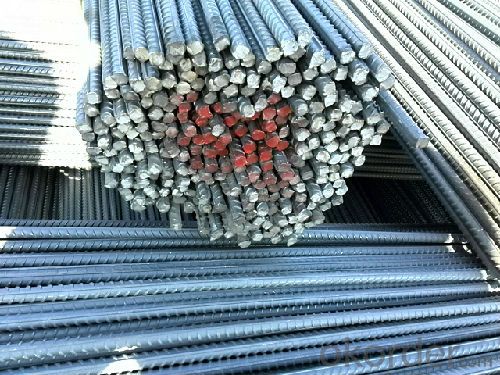
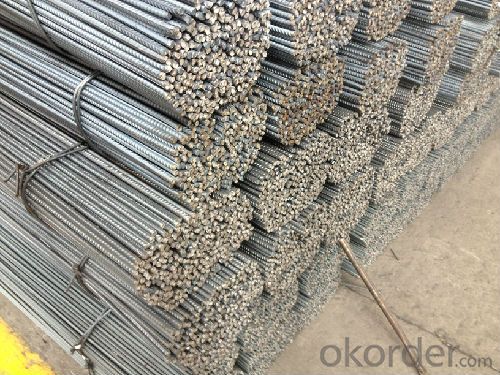
Packaging & Delivery of Hot Rolled Deformed Steel Rebars for Construction ASTM GR40,60
Packaging Detail: products are packed in bundle and then shipped by container or bulk vessel, deformed bar is usually naked strapping delivery, when storing, please pay attention to moisture proof. The performance of rust will produce adverse effect.
Delivery Detail: within 45 days after received advanced payment or LC.
Label: to be specified by customer, generally, each bundle has 1-2 labels
Note:
1. Our products are produced according to national standard (GB), if not, supply according to national standards (GB) or agreement as customer required.
2. Other Grade and Standard Deformed Steel Bar we can supply:
Grade: GR40/GR60, G460B/B500A/B500B/B500C,BST500S
Standard: ASTM, BS, DIN
The Minimum Order Quantity of these products is high, and need to be confirmed.
3. We can not only supply Deformed Steel Bar; if you need anything about building materials, please contact us for further information.
4. Please send us your detail specifications when inquire. We will reply to you as soon as possible. We sincerely hope we can establish a long stable business relationship.
FAQ:
Q1: What is the normal tolerance of Hot Rolled Deformed Steel Rebars for Construction ASTM GR40,60?
A1: Normally 3%-5%, but we can also produce the goods according to the customers' requests.
Q2: Can fit in the containers of 20fts the Hot Rolled Deformed Steel Rebars for Construction ASTM GR40,60?
A2: No proble, we can put them into the containers in the form sideling.
Q3: The products are invoicing on theoritical weight or on actual weight?
A3: We can do it in both manners, according to the customers' request.
- Q: 25 screw steel, how many meters per meter?
- Ordinary hot rolled steel bars are made up of HRB and the minimum yield point of the brand. H, R, and B are the first letters in English for hot-rolled (Hotrolled), ribbed (Ribbed) and reinforced (Bars) three words.
- Q: What are the guidelines for installing steel rebars in concrete columns?
- The guidelines for installing steel rebars in concrete columns typically include ensuring the proper spacing and alignment of the rebars, using appropriate reinforcement sizes and types, securely tying the rebars at intersections, providing sufficient cover for the rebars, and ensuring proper anchorage and lap length for effective structural integrity. It is also important to follow any specific regulations or requirements outlined by local building codes or project specifications.
- Q: What are the different types of steel rebars used in bridge construction?
- There are several types of steel rebars commonly used in bridge construction, including carbon steel rebars, epoxy-coated rebars, stainless steel rebars, and galvanized rebars. Each type has specific properties and advantages, such as corrosion resistance, durability, or increased strength, which make them suitable for different bridge construction scenarios.
- Q: Are there any health and safety concerns related to steel rebars?
- Yes, there are several health and safety concerns related to steel rebars. Firstly, handling and lifting steel rebars can pose risks of musculoskeletal injuries such as strains, sprains, and back injuries. These rebars are heavy and often require manual handling or the use of heavy machinery, which can increase the risk of accidents and injuries. Secondly, steel rebars are often coated with chemicals to prevent corrosion. These coatings can contain hazardous substances such as toxic metals or volatile organic compounds (VOCs). Exposure to these chemicals through inhaling fumes or direct contact with the skin can lead to health issues, including respiratory problems, skin irritation, and chemical burns. Furthermore, steel rebars are commonly used in construction sites, which can be hazardous environments. Workers may face risks of falling rebars, tripping over them, or being struck by them. Additionally, improper installation or positioning of steel rebars can compromise the structural integrity of the construction, potentially leading to accidents or collapses. To mitigate these health and safety concerns, it is important to provide appropriate training and personal protective equipment (PPE) to workers handling steel rebars. Employers should also enforce proper lifting techniques and safe work practices to prevent musculoskeletal injuries. Adequate ventilation systems and the use of respiratory protection can help in reducing exposure to hazardous chemicals. Lastly, regular inspections and adherence to construction regulations can ensure the proper placement and installation of steel rebars, minimizing the risk of accidents and structural failures.
- Q: How do steel rebars prevent concrete structures from spalling?
- Steel rebars prevent concrete structures from spalling by providing reinforcement and increasing the overall strength of the concrete. Spalling refers to the cracking and breaking off of the concrete surface, usually due to the expansion of internal pressure from various external factors such as temperature changes, moisture, or structural loads. When steel rebars are embedded within the concrete, they act as a support system that helps distribute the applied loads more evenly throughout the structure. This reinforcement prevents localized stress concentrations, which can lead to spalling, by absorbing and dissipating the load. By reinforcing the concrete, rebars enhance its tensile strength and improve its ability to withstand external forces. Moreover, steel rebars also help to control the formation of cracks in the concrete. As concrete is a brittle material with low tensile strength, it is prone to cracking under stress. However, the presence of rebars inhibits the propagation of cracks by bridging them and transferring the stress to the surrounding concrete. This prevents the cracks from spreading and ultimately leads to a more durable and resilient structure. Additionally, steel rebars provide protection against corrosion. Concrete is naturally alkaline, which creates a protective layer on the steel surface, preventing it from rusting. This alkaline environment acts as a barrier against corrosion, ensuring the rebars maintain their structural integrity over time. By avoiding corrosion, the rebars can continue to provide reinforcement and prevent spalling in the concrete structure. In summary, steel rebars play a crucial role in preventing spalling in concrete structures by providing reinforcement, improving tensile strength, controlling crack formation, and protecting against corrosion. By enhancing the overall stability and durability of the concrete, rebars ensure that the structure can withstand various external pressures and maintain its integrity for an extended period.
- Q: What are the common grades of steel rebars?
- Steel rebars are commonly classified based on their yield strength, which measures the force needed to deform or bend the steel. The most frequently seen grades of steel rebars are Grade 40, Grade 60, and Grade 75. Grade 40 steel rebars possess a minimum yield strength of 40,000 pounds per square inch (psi) and are often utilized in general construction projects that require moderate strength. Grade 60 steel rebars have a minimum yield strength of 60,000 psi and are extensively employed in reinforced concrete structures like bridges, buildings, and highways. They exhibit superior strength and durability compared to Grade 40 rebars, making them suitable for heavy-duty applications. Grade 75 steel rebars have a minimum yield strength of 75,000 psi and are commonly used in high-rise buildings, dams, and other structures that demand exceptional strength and load-bearing capacity. These rebars provide the highest level of strength and are specifically designed for structures exposed to extreme conditions or heavy loads. It should be noted that the selection of the appropriate grade of steel rebars for a specific project is determined by structural engineers, considering factors such as expected loads, environmental conditions, and design specifications.
- Q: Can steel rebars be used in road construction?
- Yes, steel rebars can be used in road construction. Steel rebars provide reinforcement and enhance the structural integrity of the road, making it more durable and capable of withstanding heavy traffic loads.
- Q: How are steel rebars classified based on their shapes?
- Steel rebars are classified based on their shapes into different categories such as round, square, deformed, and flat rebars.
- Q: Can steel rebars be used in tunneling and mining operations?
- Yes, steel rebars can be used in tunneling and mining operations. Rebars, which are steel bars commonly used to reinforce concrete structures, can also be employed in underground construction projects such as tunnels and mines. These steel bars provide additional strength and stability to the structures in these environments, ensuring durability and safety. In tunneling projects, rebars are often embedded in shotcrete or concrete linings to enhance the structural integrity of the tunnel walls and prevent collapse. Similarly, in mining operations, rebars are used to reinforce the roofs, walls, and support structures within the mine, safeguarding against potential hazards such as rockfalls and cave-ins. The use of steel rebars in tunneling and mining operations is crucial for maintaining the integrity and stability of these underground structures.
- Q: How are steel rebars installed in concrete?
- Steel rebars are installed in concrete by first determining the required size and spacing of the rebars based on the structural design. Then, the rebars are cut and placed in the formwork or mold before pouring the concrete. The rebars are positioned and tied together using wire or rebar tie clips to ensure they are securely embedded within the concrete. This reinforcement enhances the strength and durability of the concrete structure.
Send your message to us
Hot Rolled Deformed Steel Rebars for Construction ASTM GR40, 60
- Loading Port:
- Tianjin
- Payment Terms:
- TT or LC
- Min Order Qty:
- 25 m.t.
- Supply Capability:
- 200000 m.t./month
OKorder Service Pledge
OKorder Financial Service
Similar products
Hot products
Hot Searches
Related keywords
